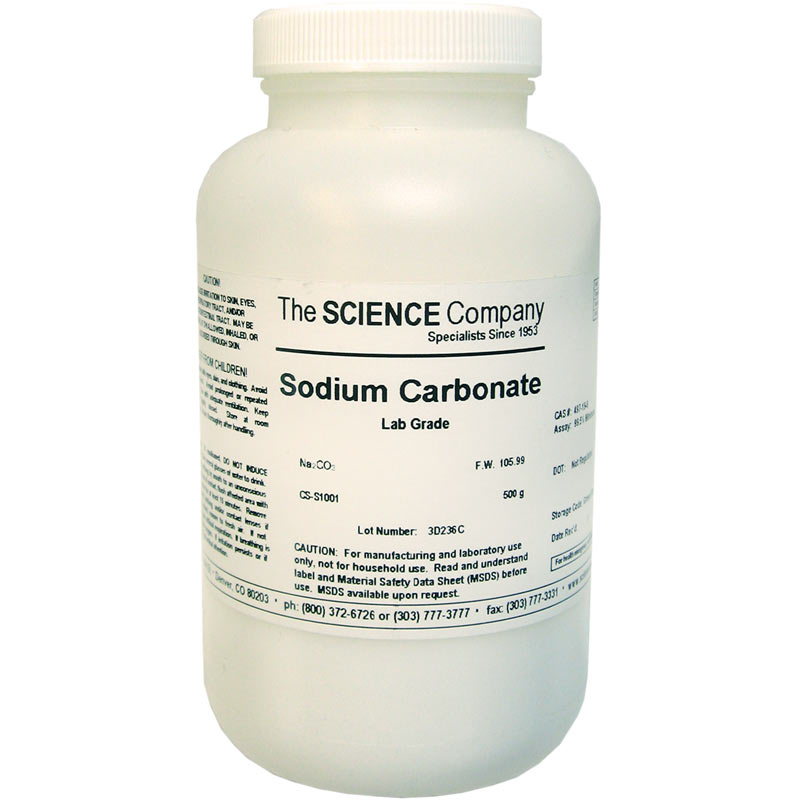Sodium carbonate or soda (Na2CO3) is a salt of sodium and carbon dioxide. In addition to food it has the E number 500.
As a salt with a weak base sodium carbonate reacts with stronger acids under formation of carbon dioxide, which escapes as a gas.
In water, it dissolves with a high heat development (dissolution heat) and forms a strong alkaline solution. Before the production of caustic soda was ash the most important used lye.
 Soda is widely used in the industry.
Soda is widely used in the industry.
Glass (largest consumer): to lower the melting point of the mixture and to improve properties (fragility, brightness, etc.) of the glass.
Chemical industry: making bleach, borax, salt, chromates, paints, fillers, tanning chemicals, detergents, adhesives and glues,..
Iron foundries: desulphurization of pig iron, cast iron and steel, and as flotation and flux.
Soap industry: detergents, cleaning products, to saponify fats.
Paper and cellulose: digestion, neutralization, cleaning and paper bleaching.
Soda dissolved in warm water is used to disinfect wounds and fight infections.
Soda is a collective name for various compounds of sodium, which in many languages also contain sodium as known:
Soda (Na2CO3)
NL: household soda, sodium carbonate, E500 (i).
English: washing soda, sodium carbonate, soda crystals, soda ash, soda carbonate.
Used to clean dirty pans, unclog the sink, make soap.
Baking soda or sodium bicarbonate (NaHCO3)
NL: baking soda, bicarbonate of soda, baking powder, bicarbonate of soda, sodium hydrogen carbonate, bicarbonate, bicarbonate of soda, baking soda, E500 (ii).
English: baking soda, sodium bicarbonate, sodium hydrogen carbonate, bread soda, cooking soda, bicarbonate of soda (sodium) bicarb.
Used as a leavening agent in dough and batter. Reacts with acid (buttermilk, vinegar, lemon juice,..) and then produces carbon dioxide bubbles. Carbon dioxide is the fizz into lemonade.
Solvay Process for the manufacture of soda
In the second half of the 18th century was searched for a process to manufacture soda, that could replace potash from salt. This led to the Leblanc process in 1791.
The more efficient Solvay process replaced it in 1861.
From limestone recovered calcium carbonate is converted into unslaked lime and carbon dioxide under the influence of heat, according to: CaCO3 → CaO + CO2
Carbon dioxide is together with ammonia lead trough a concentrated sodium chloride (table salt) solution. Ammonium reacts with chloride to form ammonium chloride (NH4Cl) and sodium hydrogen carbonate (NaHCO3) in accordance with: NaCl + CO2 + NH3 + H2O → NaHCO3 + NH4Cl
The NaHCO3 is heated to about 200°C to make water and carbon dioxide are split off. What remains is soda. This process is called calcination or calcining. 2 NaHCO3 → Na2CO3 + H2O + CO2
In the fourth step, the ammonia is recovered and recycled to step 2. 2 NH4Cl + CaO → 2 NH3 + CaCl2 + H2O
The total reaction equation of the process is summarized below:
CaCO3 + 2 NaCl → Na2CO3 + CaCl2
The calcium chloride (CaCl2) is sold as a byproduct. The ammonium in the process is recycled. There is no net carbon consumption or production. There is sodium chloride (salt) and calcium carbonate consumed.
